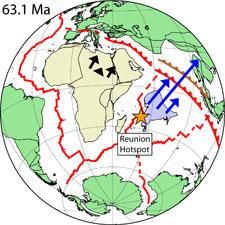
Plume from Earth's Core Smashed Continents Together

A giant plume of hot rock emerging from near the Earth's core may have sent India veering rapidly toward a collision with Eurasia while slowing Africa's drift northward soon after the end of the dinosaur age, scientists now find.
This discovery could shed light on a major new way to propel tectonic plates across the face of the planet.
The column of hot rock in question is known as a mantle plume, a massive upwelling in Earth's hot, slow-flowing mantle layer capped by a large, mushroom-like head. Deep mantle plumes are thought to rise from near the Earth's core up more than 1,550 miles (2,500 kilometers), pumping colossal amounts of heat upward. One under Réunion Island in the Indian Ocean is thought to have triggered massive volcanism, spewing lava across 580,000 square miles (1.5 million square km) at the Deccan Plateau region of what is now India about 65 million years ago, coinciding with the end of the Age of Dinosaurs.
At about the same time the Réunion plume is thought to have set off volcanoes at the Deccan Plateau, India was moving unusually rapidly across the globe. Between 68 million and 66 million years ago, India was moving at up to 7 inches (18 centimeters) a year. In comparison, between 52 million and 45 million years ago, India's motion slowed dramatically to less than 1.6 inches (4 cm) a year.
For more than 40 years, scientists have suggested the Réunion plume had driven this motion of India "and that mantle plumes in general were an important driver of tectonic plates," said researcher Steven Cande, a marine geophysicist at the Scripps Institution of Oceanography in La Jolla, Calif. "But there has never been adequate data to show that Réunion really contributed to India's fast motion, or that plumes in general drive plates."
To unearth a link between the Réunion plume and India's motion , Cande and his colleague David Stegman started looking at the motion of Africa, "since it seemed likely that if a mantle plume head was affecting India's motion, it should also affect Africa's motion," Cande said. This is because the heads of mantle plumes are thought to be quite large "one model for mantle plumes is that the plume head is over 2,000 kilometers [1,240 miles] across," Cande explained.
The scientists found that Africa's motion followed a very unusual pattern. "When India sped up 70 million years ago, Africa slowed down, and when India slowed down 50 million years ago, Africa sped up," Cande told OurAmazingPlanet. "The changes in the motion of the two plates were in sync although counter to each other."
Sign up for the Live Science daily newsletter now
Get the world’s most fascinating discoveries delivered straight to your inbox.
Not all scientists are convinced that deep mantle plumes can propel tectonic plates, or are responsible for hot spots areas of unusually high volcanic activity such as the one under Réunion island.
"Our result shows that mantle plume heads have a significant impact on plate motions," Cande said. "For the scientists who do not believe hot spots like Réunion are due to deep mantle plumes, this should be a challenge."
- Infographic: Tallest Mountain to Deepest Ocean Trench
- The 10 Biggest Volcanic Eruptions in History
- Album: Volcanoes from Space

Most Popular


